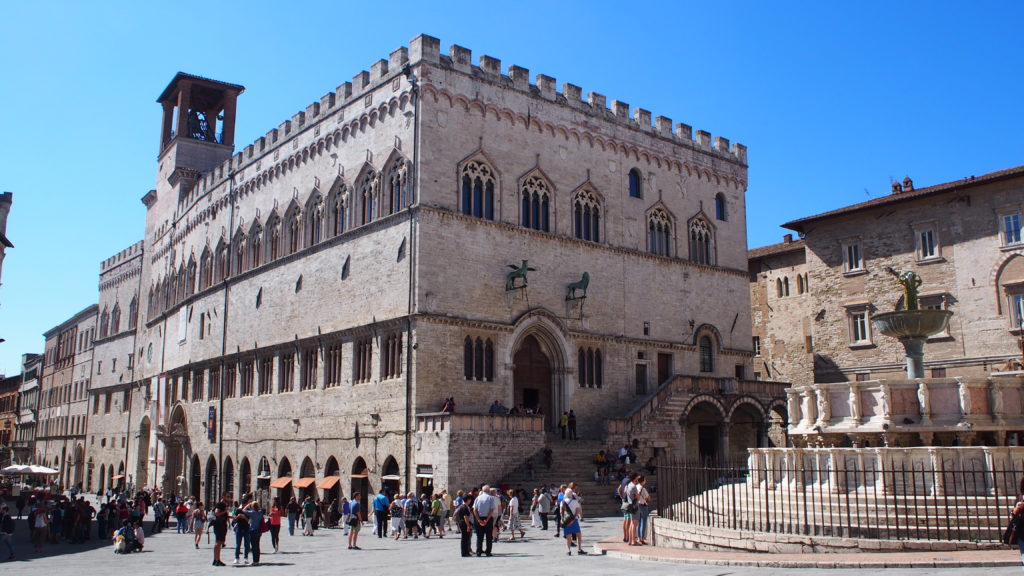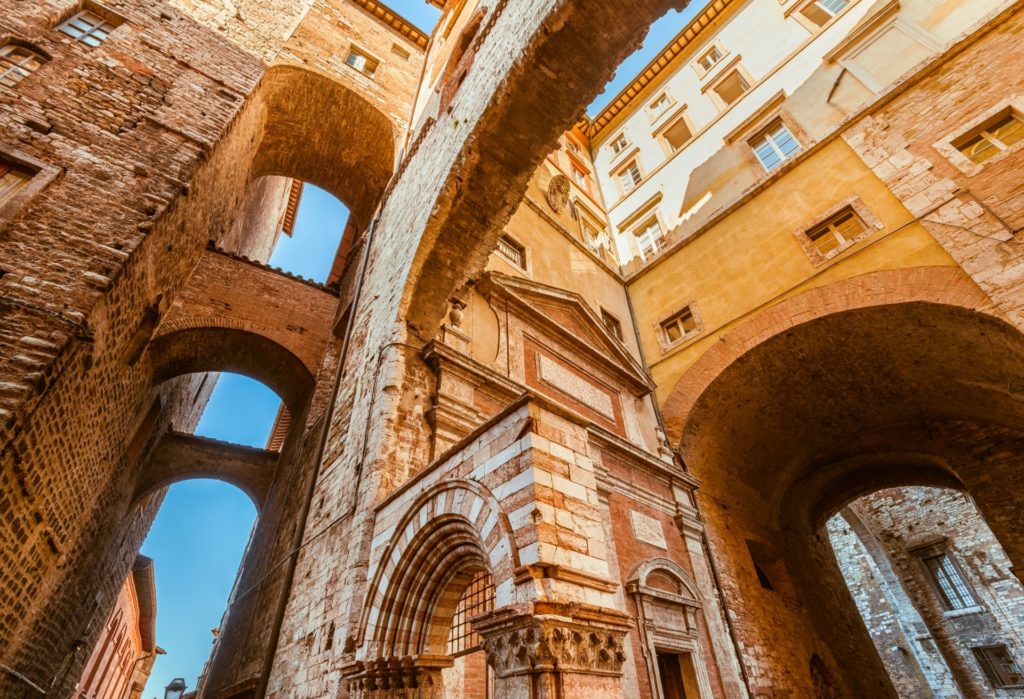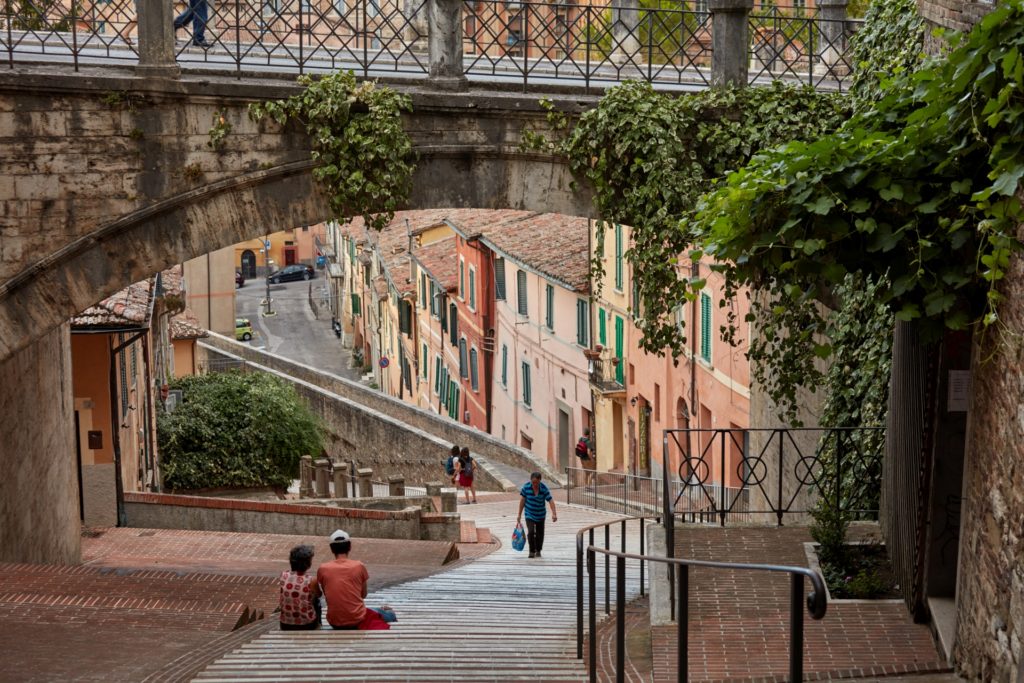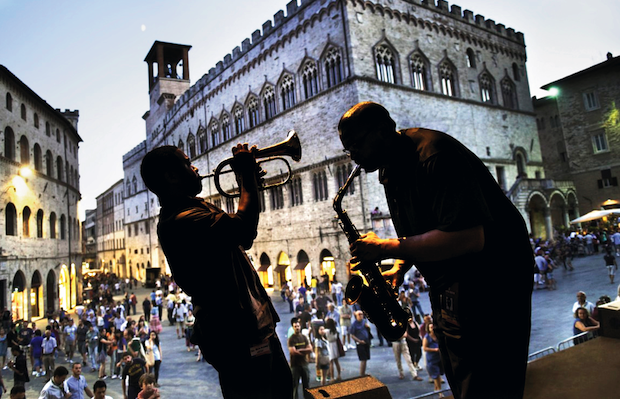Perugia, is the capital of the central Italian Region of Umbria and is a perfect base from which to explore the region.

Boasting some fantastic historic sites, annual festivals and local delicacies, Perugia rewards visitors looking to explore away from the well known cities in neighbouring Tuscany. We highlight our Top 5 reasons to make Perugia a stop on your next Italian adventure. Well, there’s actually 7 reasons, we just couldn’t limit them to 5, we wanted to share all that’s a buzz about this fantastic regional capital.
1. Piazza IV Novembre – Located in the city centre, Piazza IV Novembre (pictured above) is a place to begin or end a day of sightseeing. Originally known as Piazza Grande, its name was changed to Piazza IV Novembre to celebrate the date World War I ended in Italy. Surrounded by bustling cafes, restaurants and shops, the square is encircled by some of the city’s most famous sights. The Fontana Maggiore, a monumental medieval fountain built in the thirteenth century acts as the centre piece in the Piazza between the Palazzo dei Priori town hall and the city’s beautiful fifteenth century Cathedral.
2. Rocca Paolina – It’s difficult to imagine that directly below the present-day gardens and Piazza Italia, a bloody uprising once took place. Being a Papal State under the direct rule of the Pope, Perugia’s Rocca Paolina was a medieval fortress built in 1540 by Pope Paul III (Farnese). Standing guard over Perugia until Italy was unified in the 1860s, Rocca Paolina was destroyed by its citizens – removing this symbol of papal oppression.
What you will find today of Rocca Paolina is a maze of underground passageways, which include remains of ancient towers, chambers, vaulted ceilings and even a communal bread-baking oven. One entrance, the Porta Marzia (Mars Gate) boasts the upper part of an Etruscan gate dating back to the third century BC.
Despite Rocca Paolina’s savage history, these once vibrant streets of an ancient, medieval city are very much a part of modern-day Perugia where it hosts various cultural events throughout the year including farmers markets and a Christmas market in December.


3. Delicacies of Perugia – Food in Perugia and in Umbria is uncomplicated and hearty. You’ll find meats are a staple for the locals, particularly pork and gamey flavours such as wild boar and hare. Porchetta, made from an entire pig which is boned, stuffed with garlic, fennel, rosemary and slowly roasted until the skin is golden and crisp is also a must-try local delicacy.
Pasta dishes are also popular (surprise, surprise). Keep an eye out for Pasta alla Norcina, one of the signature pasta dishes of the region. Penne or rigatoni pasta in a rich creamy sauces with porcini mushrooms, shaved black truffle and sausage. This hearty pasta dish hails from the nearby provincial town of Norcia but is found all throughout the region. Oh, and don’t forget to add plenty of Pecorino cheese.
One of our restaurant recommendations to try Pasta alla Norcina and other great local dishes in Perugia is at ‘Al Mangiar Bene’, a trattoria located within walking distance from Piazza IV Novembre. Good traditional cuisine in an authentic setting.
4. Perugia’s Own Chocolate Factory, Casa del Cioccolato Perugina – Baci, Baci, Baci. Established in 1907, the Perugina company originally opened a laboratory to manufacture sugared almonds. It wasn’t until 1921 when the Luisa Tablet was introduced as their first chocolate, inspired by one of the Perugina founders, Luisa Spagnoli.
In 1922, a new chocolate by Luisa, named The Cazzotto arrived which would later be renamed Baci. This famous chocolate with dark chocolate praline and hazelnut is famous the world over as the unmistakable sweet messenger of love. Fast-forward to today, the Perugina company is not shy of innovation, bringing to the market various recipes, degrees of cocoa and something closer to the cocoa bean taste, offering a Raw Taste range. One wouldn’t need much convincing, but a visit to the Perugina Chocolate Factory is a favourite, there’s the Museum, the Factory, the tasting room and even a Chocolate school to attend.
Mmmmm, you can almost taste the chocolate on your senses. But, if you are a little time poor and can’t make it just outside the city to the Perugina Factory, then pop into Pasticceria Sandri. Located in the heart of the historical centre of Perugia, Pasticceria Sandri dates back to 1860 and is known as one of the city’s best pastry shops. There you will be able to get your Baci fix along with numerous other chocolates and sweets.
Otherwise if you time your visit to Perugia in the month of October there is also the annual chocolate festival, EuroChocolate!
5. The Arch of the Aqueduct (Arco di Via Appia) – Constructed in the late 13th Century, the Arch of the Aqueduct is one of many medieval arches in Perugia. Said to have been constructed around the same time as the Aqueduct which was carrying water from Mount Pacciano to Piazza IV Novembre, this arch is fascinating. Today, the narrow paths of the Aqueduct are used by locals as a way into the city centre, a standout for a lovely morning or late afternoon walk.


6. Umbria Jazz Festival – Held annually since 1973, the Umbria Jazz Festival is one of the most important Jazz festivals in the world. Held in July, over ten days, the festival hosts both local and International Jazz artists. The festival has hosted Jazz greats such as Miles Davis, Charles Mingus and Dizzy Gillespie as well as more contemporary acts such Alicia Keys, Lady Gaga and Prince. Originally, being free events and held amongst the most beautiful sites around Perugia, so popular was the festival that logistics had to improve, so the Umbria Jazz Association was born to help the festival continue its great success today.
7. Study in Umbria – Commonly referred to ‘The big university town in a small Italian city’, Perugia is the home of many small Colleges and established Universities. With academic institutions dating back to 1921, foreign students can select from a variety of courses. Perugia being a University city also means there is always exciting things going on, which means you won’t struggle to find something to see and do.
History, food, chocolate, music and language there is so much to this regional capital worth exploring. Vita Italian Tours Best of Tuscany, Umbria & Le Marche is a small group tour that takes you through to experience the highlights of what’s known as the ‘Green Heart’ of the Italian Peninsula, and includes a visit to the city of Perugia. Mario and Gianni of Vita Italian Tours also devise private tours and itineraries for travellers wishing to visit this extraordinary city and its surrounds.

